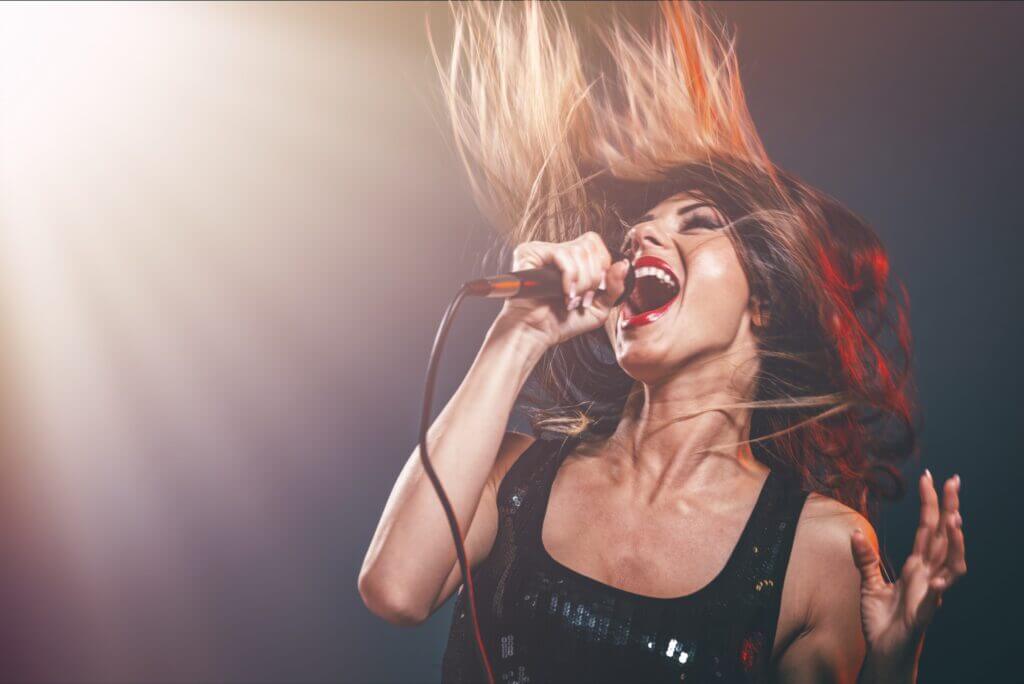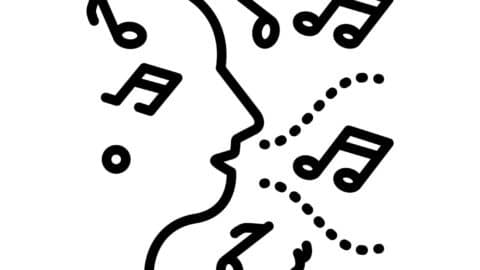When you sing, your voice is your instrument. But on stage, with a loud band behind you, your voice doesn't come through. There you need a microphone and a sound system. Microphone plus amplification: that is the extended instrument of the singer.
It's not just about volume - being able to sing against a band, for example, against a drummer who alone can blast out an ear-splitting 110 decibels. The microphone can bring a voice so close to the listener that it is as if he is sitting next to the singer in a confidential conversation or as if she is whispering something to him, just for him. Just about any sound quality of our voice can be amplified by the microphone, connected to a mixer and speakers - from the loudest to the softest sounds or whispers.
Two microphone types
If it gets really loud on stage, like at a rock or pop live gig, dynamic microphones are a good choice for the front woman or man. They amplify the vocal sound directly in front of the microphone, with rapidly decreasing sensitivity at greater distances. This means that noise or sound sources further away, such as drums or instruments, are hardly picked up by the microphone, and, most importantly, on narrow stages: The danger of electronic feedback is low.
For softer voices or softer, more intimate singing styles, this means getting as close to the vocal mic as possible. Maybe you've noticed how a singer seems to have his mouth glued to the metal grille of his microphone all the time? Then he had a dynamic microphone and additionally used the so-called proximity effect: If you go very close to a dynamic microphone with your lips, it amplifies the bass range of the vocal sound - the singing sounds fuller and richer. Conversely, for louder vocal passages, you have to increase the distance to the microphone.
In contrast to dynamic microphones, condenser microphones have a high sensitivity, but they also reproduce the sound spectrum of the voice more naturally. These mics are also good at transmitting the quietest and smallest nuances of intonation, such as breathy flow, vocal fry (the creaky sound of the voice) or intimate emotional colourings of the sound. Because of their clarity and brilliance, condenser mics are used especially in the studio for recordings.
Condenser microphones are used live, for example, in jazz, folk music, musicals (via headsets) or on cabaret stages. Please note: Conventional condenser microphones require an additional power supply. The mixing console must be equipped with "phantom power", also recognisable by the label "+48v". Some newer condenser microphones no longer need phantom power, it is already integrated into the microphones.
Mixer and effects
Microphones are only the first link in the signal chain that finally comes out of the speakers as sound. The next link is the mixing console or mixer. With the mixer, frequency ranges can be raised or lowered depending on the preferred sound aesthetics, e.g. a muffled sound or a sound transmitted muffled by the microphone can be given more brilliance by turning up the treble control.
Effects such as reverb or echo are also integrated into the mixer. A light reverb, for example, is recommended to give the voice more or less space, which otherwise comes too directly and dryly from the loudspeaker. Another effect device is the compressor, which automatically adjusts the volume level of the vocals by buffering loud parts and boosting quieter parts. In musical theatre, where vocals are transmitted via headset microphones, the use of a compressor is helpful.
Loudspeaker and monitor system
To complete a sound system, you need an amplifier (if not already integrated into the mixing console) and speakers. A classic is a speaker system consisting of (a) "sub woofers", large speakers at the bottom for the bass frequencies, and (b) "tweeters" or satellites, smaller speakers at the top for the treble frequencies, connected by a distance rod.
Here, too, something important is missing. At a live gig, the speaker system is at the side of the stage and facing the audience - from the stage, their sound is lost far back in the room. With the drums behind us, with the guitar amps turned up, etc., we can hardly hear our own voice while we sing. With the result that we sing too loudly or even sing incorrectly.
That's why we also need a monitor box that faces us on stage and gives us the necessary acoustic feedback when we sing. For professionals who perform on big stagesIf you're a musician, in-ear monitoring systems can be worth buying, also because well-fitted earplugs dampen the volume on stage. Because, what we should always keep in mind: Sustained noise at a volume of 85 decibels or more can already damage the hearing, and at live gigs, volumes of over 100 dB are not uncommon on stage.
Tips for buying a microphone and getting off to a good start
It's a cliché: the musicians drag their equipment onto the stage, the singer comes with his microphone. Singers have it easier here, they already bring their instrument, the voice, with them. Aspiring singers who want to prepare for their first live performances only need a microphone, which they connect to the existing PA system.
When buying a microphone, it is advisable to take along someone you trust who has good hearing. You might even ask your vocal coach. I, for example, like to accompany my students when they want to buy a microphone and give them advice.
Decide in advance whether you want to buy a dynamic microphone or a condenser microphone. Then go to the shop and get all the vocal microphones that are available for your budget. Good shops have rooms where you can connect the microphones to amplifiers and try them out individually. This is worthwhile because not every good microphone is a good microphone for your voice.
When choosing a microphone, your companion and the salesperson should be there to advise you until you have two microphones on the shortlist. For the final decision, it is good to have additional playbacks with you in which you use your voice differently, sometimes very loud, sometimes soft - just as you need it for your performance. Apart from the sound, the following also plays a role: How heavy is the microphone and how does it feel in your hand, in short: Do you feel comfortable with it? In this way, you are sure to find a microphone that will accompany you for many years and give you pleasure.
A dynamic microphone is a good start for the aspiring singer (plus a microphone stand if necessary) as well as a monitor box. Then you can start with the microphone training. Our tip: First of all, familiarise yourself with your microphone by trying out a few things:
- Step a few centimetres in front of your microphone. Sing a phrase at a medium pitch and change the distance: get so close that your lips almost touch the mic, then slowly move further and further away. Listen to how the sound changes (close: bassy, far: flat) and try to find the distance at which you like the sound profile of your voice best.
- Repeat the whole 1) with a very soft, e.g. whispered or head voice vocal passage, 2) with a loud voice, perhaps a phrase in a high register with a full voice. 3) Find out how you need to change the distance to the mic to sing a song with both quiet and loud passages with the same volume output. The rule of thumb here is to move further away from the mic for louder parts and closer for quieter ones.
- Sing the consonants softer than you would without electronic amplification. Hard consonants such as "k", "p" or "t", but also sibilants, cause small explosions of air in front of your microphone (called "plosives"). These plosives overload the speakers and lead to clipping in recordings. Therefore, sing the consonants with less air pressure, muffled, i.e. a "k" more like a "g", a "p" more like a "b", the "t" more like a "d". It is unusual but can be learned: You can also sing in a high register with a full voice ("belten") and sing with less explosive consonants than you are used to.
Have fun experimenting!






